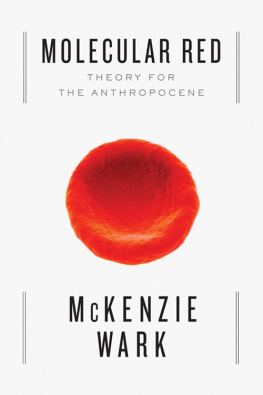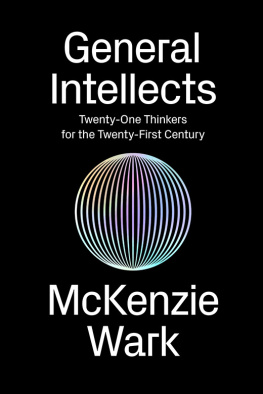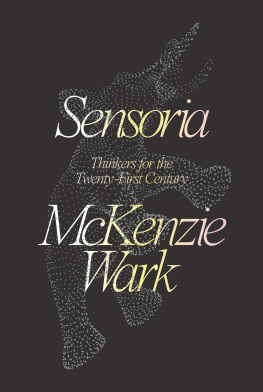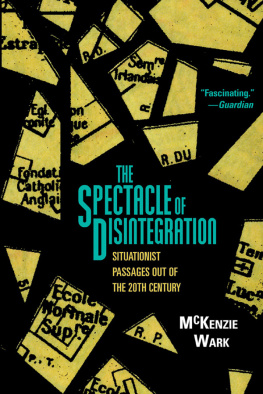MOLECULAR RED:
Theory for the Anthropocene

McKenzie Wark

First published by Verso 2015
McKenzie Wark 2015
All rights reserved
The moral rights of the author have been asserted
1 3 5 7 9 10 8 6 4 2
Verso
UK: 6 Meard Street, London W1F 0EG
US: 20 Jay Street, Suite 1010, Brooklyn, NY 11201
www.versobooks.com
Verso is the imprint of New Left Books
ISBN-13: 978-1-78168-827-4
eISBN-13: 978-1-78168-828-1 (UK)
eISBN-13: 978-1-78168-829-8 (US)
British Library Cataloguing in Publication Data
A catalogue record for this book is available from the British Library
Library of Congress Cataloging-in-Publication Data
Wark, McKenzie, 1961
Molecular red : theory for the Anthropocene / McKenzie Wark.
pages cm
Includes bibliographical references and index.
ISBN 978-1-78168-827-4 (paperback : alkaline paper) ISBN 978-1-78168828-1 (electronic : US) ISBN 978-1-78168-829-8 (electronic : UK) 1. Global environmental changeSocial aspects. 2. Atmospheric carbon dioxideEnvironmental aspects. 3. Climate change mitigationPhilosophy. 4. Bogdanov, A. (Aleksandr), 18731928Criticism and interpretation. 5. Platonov, Andrei Platonovich, 18991951Criticism and interpretation. 6. Haraway, Donna JeanneCriticism and interpretation. 7. Robinson, Kim StanleyCriticism and interpretation. 8. Labor in literature. 9. Nature in literature. 10. Utopias in literature. I. Title.
GE149.W27 2015
363.73874dc23
2014043301
Typeset in Adobe Garmond by Hewer Text UK Ltd, Edinburgh, Scotland
Printed in the US by Maple Press
For Vera:
Hoc et cogitatione et realitate vera est.
Mother historys made monsters of the lot of us!
Andrey Platonov
All that is unhuman is not un-kind.
Donna Haraway
Contents
Workings of the world untie! You have a win to world!
The Cyborg International
Disparate times call for disparate methods. Lets just say that this is the end of pre-history, this moment when planetary constraints start really coming to bear on the ever-expanding universe of the commodification of everything. This is the worldview-changing realization that some now call the Anthropocene. Lets not despair. Some of the greatest accelerations in the life of our species-being have happened in moments of limit, if never before on such a scale.
The Anthropocene is the name Paul Crutzen and others give to this period of geological time upon which the planet has entered. Crutzen:
About 3050 percent of the planets land surface is exploited by humans More than half of all accessible fresh water is used by mankind. Fisheries remove more than 25 percent of the primary production in upwelling ocean regions Energy use has grown sixteen-fold during the twentieth century More nitrogen fertilizer is applied in agriculture than is fixed naturally in all terrestrial ecosystems.
The human is no longer that figure in the foreground which pursues its self-interest against the background of a wholistic, organicist cycle that the human might perturb but with which it can remain in balance and harmony, in the end, by simply withdrawing from certain excesses.
This is not the end of pre-history that the main currents of critical theory thought they would encounter. So perhaps we need some new critical theory. Or new-old, for it turns out that there was a powerful and original current of thought that was all but snuffed out in a previous, failed attempt to end pre-history. There may even be more than one. But the one I offer here in the first part of this book, Labor and Nature, bears the names of two Russian Marxist writers, Alexander Bogdanov and Andrey Platonov.
Once we are equipped with this preterite thought, we can set it to work. In the second part, Science and Utopia, we move from the cold and hunger of early Soviet Russia to the sunshine and plenty of California at the end of the twentieth century. The feminist science studies scholar Donna Haraway and the science fiction writer Kim Stanley Robinson are avatars of two approaches to thinking and writing at the end of this pre-history that echo and update Bogdanov and Platonov for our self-consciously Anthropocene times.
Common sense has it that the Cold War is over, that the Soviet Union lost and the United States won. While some would wish to hibernate in some psychic soviet, the dominant mood is that regnant American-style capitalism won a global victory. The historic arc of Molecular Red is different. In this version, the collapse of the Soviet system merely prefigures the collapse of the American
A traveler among the antique ruins comes across the shattered visor of a rusting ship, half sunk in sand. Round the decay of this colossal wreck nothing beside remains; only desperation, boundless and bare. The name of this vessel has peeled off, but it might as well be named after Ozymandias, the fabled Egyptian king of Shelleys poem, and his challenge Look on my works, ye Mighty, and despair!
Beyond this rusting hull lies innumerable others. This is a modern ruin, mass-produced. And it is not just sand or time that ruined it. This dusted Martian landscape is one of the Seven Wonders of the World in negative. The vast and now gone waters that these ships once plied was the Aral Sea, which is less than a tenth of its former size.
There were once pharaoh-sized statues here too. The Aral Sea is in what was once the Soviet Union, so perhaps the statues were of Lenin, pointing to a future rather remote from this one. But the ship itself is a wreck that recalls a power of a different kind: the capricious stubbornness of the natural world.
Cotton-growing actually began in this region when the American Civil War cut off Russias cotton supply. After the revolution, Soviet engineers tapped the Amu Darya River that flowed into the Aral Sea as a water source for a cotton industry. The Soviets greatly expanded cotton production as an export crop after World War Two, and built vast irrigation projects to this end. Enormous quantities of water were an input, mixed with soil and seed and fertilizer, to grow cotton plants. The engineers knew the Aral Sea would disappear. Its fishing fleet was collateral damage, and so too perhaps were the many species of plant and animal now fossilizing here.
This is an example of what, after Marx, we might call metabolic rift. Labor pounds and wheedles rocks and soil, plants and animals, extracting the molecular flows out of which our shared life is made and remade. But those molecular flows do not return from whence they came. The waters diverted from the Aral Sea to the cotton fields did not come back. As Marx knew, agriculture is a maker of deserts.
The Anthropocene is a series of metabolic rifts, where one molecule after another is extracted by labor and technique to make things for humans, but the waste products dont return so that the cycle can renew itself. The soils deplete, the seas recede, the climate alters, the gyre widens: a world on fire. Earth, water, air: there is a metabolic rift where the molecules that are out of joint are potassium nitrate, as in Marxs farming example; or where they are dihydrogen-oxide as with the Aral sea; or where they are carbon dioxide, as in our current climate change scenario.














